
A rangefinder camera is a camera fitted with a rangefinder, typically a split-image rangefinder: a range-finding focusing mechanism allowing the photographer to measure the subject distance and take photographs that are in sharp focus. Most varieties of rangefinder show two images of the same subject, one of which moves when a calibrated wheel is turned; when the two images coincide and fuse into one, the distance can be read off the wheel. Older, non-coupled rangefinder cameras display the focusing distance and require the photographer to transfer the value to the lens focus ring; cameras without built-in rangefinders could have an external rangefinder fitted into the accessory shoe. Earlier cameras of this type had separate viewfinder and rangefinder windows; later the rangefinder was incorporated into the viewfinder. More modern designs have rangefinders coupled to the focusing mechanism so that the lens is focused correctly when the rangefinder images fuse; compare with the focusing screen in non-autofocus SLRs.
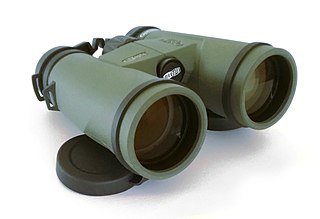
Binoculars or field glasses are two refracting telescopes mounted side-by-side and aligned to point in the same direction, allowing the viewer to use both eyes when viewing distant objects. Most binoculars are sized to be held using both hands, although sizes vary widely from opera glasses to large pedestal-mounted military models.

Leica Camera AG is a German company that manufactures cameras, optical lenses, photographic lenses, binoculars, rifle scopes and microscopes. The company was founded by Ernst Leitz in 1869, in Wetzlar, Germany.

A monocular is a compact refracting telescope used to magnify images of distant objects, typically using an optical prism to ensure an erect image, instead of using relay lenses like most telescopic sights. The volume and weight of a monocular are typically less than half of a pair of binoculars with similar optical properties, making it more portable and also less expensive. This is because binoculars are essentially a pair of monoculars packed together — one for each eye. As a result, monoculars only produce two-dimensional images, while binoculars can use two parallaxed images to produce binocular vision, which allows stereopsis and depth perception.

Carl Zeiss AG, branded as ZEISS, is a German manufacturer of optical systems and optoelectronics, founded in Jena, Germany in 1846 by optician Carl Zeiss. Together with Ernst Abbe and Otto Schott he laid the foundation for today's multi-national company. The current company emerged from a reunification of Carl Zeiss companies in East and West Germany with a consolidation phase in the 1990s. ZEISS is active in four business segments with approximately equal revenue in almost 50 countries, has 30 production sites and around 25 development sites worldwide.

In optics, a Porro prism, named for its inventor Ignazio Porro, is a type of reflection prism used in optical instruments to alter the orientation of an image.

Minolta Co., Ltd. was a Japanese manufacturer of cameras, camera accessories, photocopiers, fax machines, and laser printers. Minolta Co., Ltd., which is also known simply as Minolta, was founded in Osaka, Japan, in 1928 as Nichi-Doku Shashinki Shōten. It made the first integrated autofocus 35 mm SLR camera system. In 1931, the company adopted its final name, an acronym for "Mechanism, Instruments, Optics, and Lenses by Tashima".

An Abbe–Koenig prism is a type of reflecting prism, used to invert an image. They are commonly used in binoculars and some telescopes for this purpose. The prism is named after Ernst Abbe and Albert Koenig.
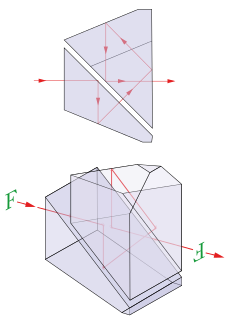
A Schmidt–Pechan prism is a type of optical prism used to rotate an image by 180°. These prisms are commonly used in binoculars as an image erecting system. The Schmidt–Pechan prism makes use of a roof prism section. Binoculars designs using Schmidt–Pechan prisms can be constructed more compactly than ones using Porro or Uppendahl roof and Abbe–Koenig roof prisms.

Carl Kellner was a German mechanic and self-educated mathematician who founded in 1849 an "Optical Institute" that later became the Leitz company, makers of the Leica cameras.
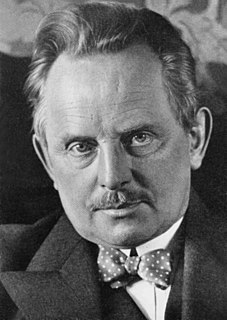
Oskar Barnack was an inventor and German photographer who built, in 1913, what would later become the first commercially successful 35mm still-camera, subsequently called Ur-Leica at Ernst Leitz Optische Werke in Wetzlar.
Walter Mandler was a lens designer of Ernst Leitz Canada in Midland, Ontario. Mandler is credited with the design of more than 45 Leica lenses for the Leica rangefinder cameras and Leica SLR cameras.
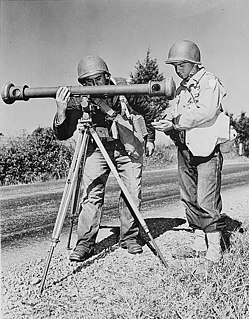
A coincidence rangefinder or coincidence telemeter is a type of rangefinder that uses mechanical and optical principles to allow an operator to determine the distance to a visible object. There are subtypes split-image telemeter, inverted image, or double-image telemeter with different principles how two images in a single ocular are compared. Coincidence rangefinders were important elements of fire control systems for long-range naval guns and land-based coastal artillery circa 1890–1960. They were also used in rangefinder cameras.
Noblex, formerly Docter Optics, is a German manufacturer of optics, including binoculars, rifle scopes, spotting scopes, red dot sights, flashlights and reading glasses. Its headquarters are in Eisfeld, Thuringia, Germany, where most of the products are developed and manufactured. Docter is part of the Analytik Jena Group.
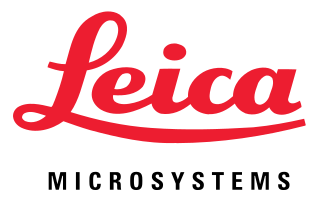
Leica Microsystems GmbH is a German microscope manufacturing company. It is a manufacturer of optical microscopes, equipment for the preparation of microscopic specimens and related products. There are ten plants in eight countries with distribution partners in over 100 countries. Leica Microsystems emerged in 1997 out of a 1990 merger between Wild-Leitz, headquartered in Heerbrugg Switzerland, and Cambridge Instruments of Cambridge England. The merger of those two umbrella companies created an alliance of the following 8 individual manufacturers of scientific instruments. American Optical Scientific Products, Carl Reichert Optische Werke AG, R.Jung, Bausch and Lomb Optical Scientific Products Division, Cambridge Instruments, E.Leitz Wetzlar, Kern & Co., and Wild Heerbrugg AG, bringing much-needed modernization and a broader degree of expertise to the newly created entity called Leica Holding B.V. group. In 1997 the name was changed to Leica Microsystems and is a wholly-owned entity of Danaher Corporation since July 2005. Danaher is a US venture capital company.
Ernst Leitz GmbH was a German corporation now divided into four independent companies:
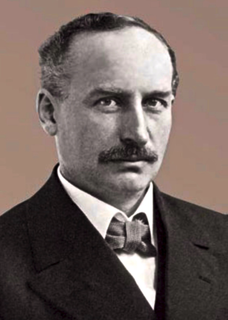
Ernst Leitz II was a German business person and humanitarian. He was the second head of the optics company now known as Leica Camera and organized the Leica Freedom Train to allow people, most of whom were Jewish, to escape from Germany during Nazi times.

A Perger prism or Perger–Porro prism system is a prism, that is used to invert an image. The special feature of this prism is that, like a traditional double Porro prism system, it manages this with only four beam deflections and has neither a roof edge with the accompanying phase correction problems, a mirrored surface or an air gap. However, in contrast to the traditional double Porro prism, it leads to a significantly reduced eyepiece/objective axis offset. The reduced beam offset allows for slimmer, more straight binocular housings usually found in roof prism binoculars. Complicating production requirements make high-quality roof prism binoculars relatively costly to produce compared to in optical quality equivalent Porro prism or "Perger–Porro prism system" binoculars.
A prism sight or prismatic sight, sometimes also called prism scope or prismatic scope, is a type telescopic sight which uses a roof prism for its image-erecting system. The use of prisms makes it possible to construct a shorter and lighter sight, or with an offset between the eyepiece and objective axes.
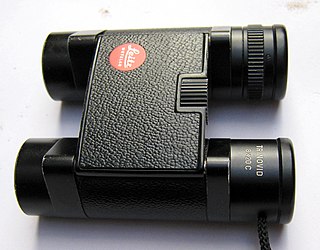
An Uppendahl prism is an erecting prism, i.e. a special reflection prism that is used to invert an image. The erecting system consists of three partial prisms made of optical glass with a high refractive index cemented together to form a symmetric assembly and is used in microscopy as well as in binoculars technology.

















